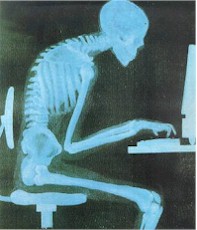 |
| Is this you? |
Which is why future episodes of LBP should guide your current decision making. If you’ve been raking the yard all morning and your back starts to hurt, do you acknowledge it and stop for the day or push on into the afternoon until the task is complete (regretting it the next morning)? How about road trips? You can drive until the full tank of gas is gone ignoring the dull ache that has slowly started creeping up your spine or you can stop every two hours to fill up and move around. With this change of position you improve your circulation through movement and it will make a difference to your body.
Most of us work with computers these days and know what a time suck they can be. Before you realize it, you’ve been sitting there for hours. One way you can deal with this lack of motion is by varying your job tasks so you are forced to get up and move around. Keeping books, files, the printer, even the stapler out of your reach has it's benefits by getting you up and moving. If you have to, set a timer to go off every 30 minutes and then stand for a second, do the been sittin too long shimmy (shift your hips back and forth), and then sit back down. If you’re working on a laptop, try moving it to a higher level, like a counter top or cabinet, where you can stand and work for a while. There are also many sit/stand work options available these days to support these efforts (here's an interesting large scale case study on health care cost savings at a company utilizing adjustable work options).
Make sure you’re not leaning into the screen either, which can wreak havoc on your neck or upper back as well as contribute to LBP. The rule of thumb is, your line of reading should be approximately two inches below the top of the screen. Adjust the height of your chair, if you can, or elevate your monitor in some way (text books are good for more than just reading). The point being, don’t ignore your pain or be afraid of it; do let it guide you in your decision making process. For those of you who spend your entire day at the computer, you may be interested in this office yoga or a free download with pop-up reminder exercises you can do at your desk (it's not just for kids). Remember to pay attention to your other body cues too, such as:
- Numbness, burning or tingling;
- Soreness, aching or tenderness;
- Pain, throbbing or swelling;
- Tightness or stiffness;
- Weakness, fatigue, or cold.


